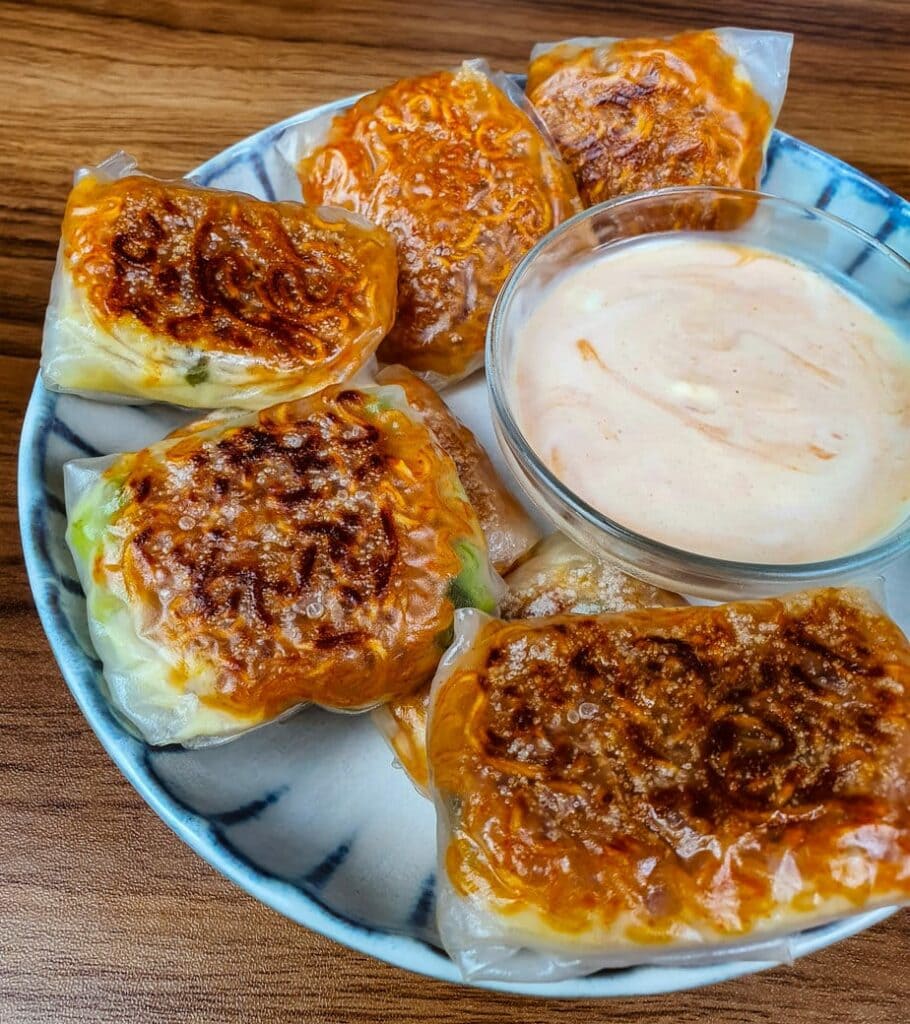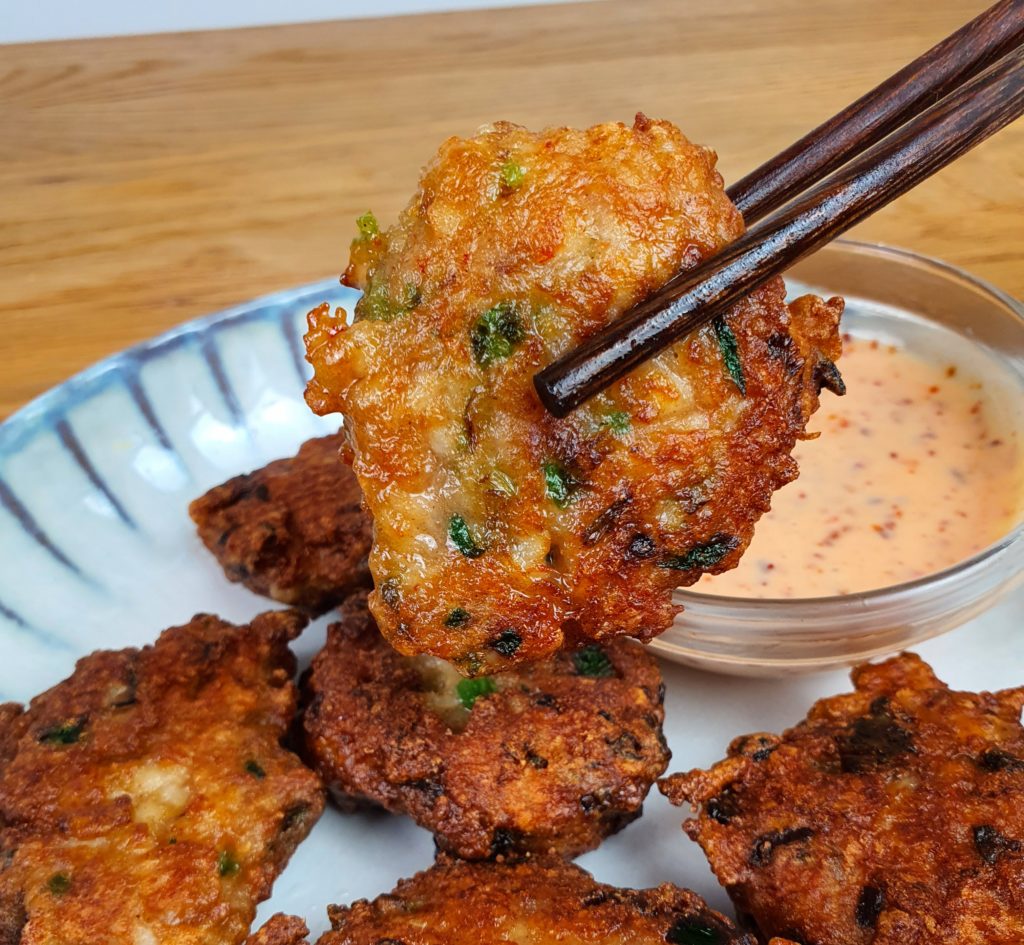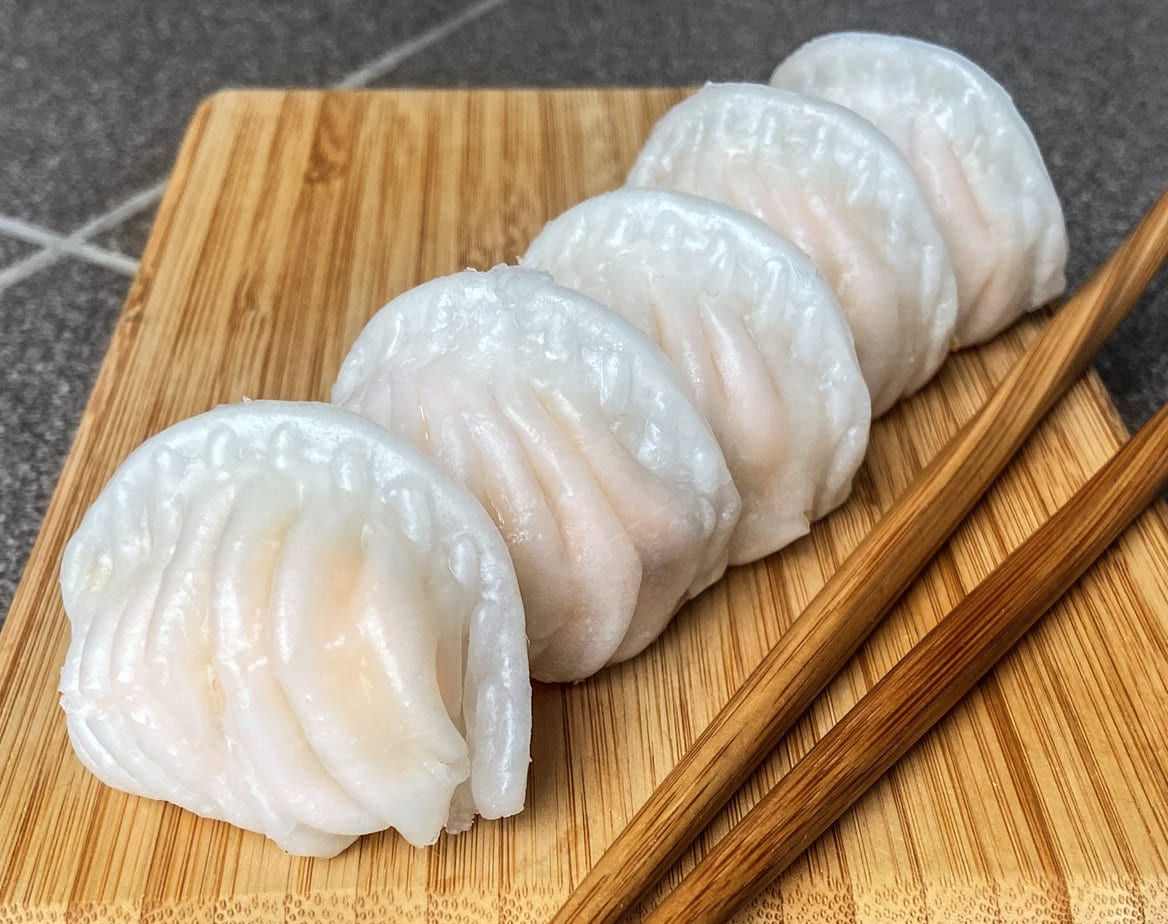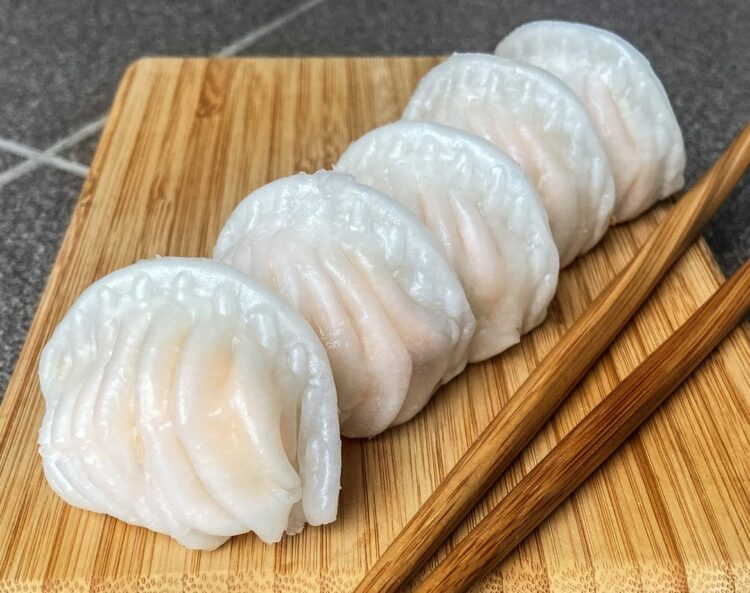Today, I’m sharing the recipe for one of the most requested dim sum dishes: Har Gow, also called Ha Kao or Ha Cao—the famous crystal-skinned steamed shrimp dumplings.
Now, before we get to the heart of the matter, a quick word of warning: Har Gow are hard to make—really, truly hard.
If you can buy good ones inexpensively nearby, there’s no real reason to make them yourself. This isn’t the kind of dish you’ll whip up on a Thursday-night whim.
The only reason to make Har Gow, in my view, is to prove to yourself that you can—or you simply have the time and want to maximize the quantity-quality-price ratio.

Because yes, usually in a Chinese restaurant, you’ll get at most three or four per plate… This recipe makes 30.
There’s something deeply satisfying about having a whole steamer basket of Har Gow in front of you and being able to devour them with abandon as if they were simple appetizers.
What is Har Gow (Ha Kao)?
Har Gow are a type of dim sum with a slightly sweet shrimp filling, characterized by a translucent wrapper. The word “ha kao” means “bride’s hat” in Cantonese because the dumpling’s shape resembles the traditional bridal hairstyle of southern China.
Origin and history of Har Gow
Har Gow originated in China, reportedly in the southern region of Guangdong province, where they remain especially beloved.
They date back to the Ming dynasty, though the exact date is unknown… In short, just remember they’re old, traditional, and delicious. source
Key ingredients for Har Gow—and why they matter: a few tips to nail them every time
Pork fat: Adds richness to the dumpling’s flavor—don’t omit it.
Lard: Rendered pork fat. In the filling, it improves the overall texture, and it’s crucial in the dough for that glossy, translucent finish once the dumpling is steamed. You can buy some here on Amazon
Why wash the shrimp? A brief technical explanation is in order: with the salt and water, we’re removing the thin layer of glycosylated protein on the surface of the shrimp.
This helps the shrimp keep their “snap” throughout cooking. If you’ve tried making Har Gow and the filling’s texture didn’t resemble what you get at restaurants, this is why.
A quick final note
My recipe is clearly not the first recipe out there for making Har Gow. Generally, the Ha Kao recipes I’ve seen aren’t too bad, all things considered.
That said, there’s a recurring problem on blogs, whether for Har Gow or other dishes: people add too many unnecessary extras to the filling.
The Har Gow filling, at its core, should be three things: shrimp, pork fat, and a mix of bamboo shoots and water chestnuts.

Do not add ground pork. Skip aromatics like ginger or scallions. No shiitake mushrooms. No oyster sauce. And definitely no carrots or bell peppers. They completely throw off the flavor when added the way I’ve seen…
Still, you’re absolutely free to play with the proportions—don’t hesitate; that’s how the best discoveries are made.
But it’s best to perfect the original first, then start experimenting. If anything, omit ingredients that are truly unavailable where you live; just don’t (at first) substitute or add new ones.
A much easier (but no less delicious) option is my Chinese pork dumplings recipe.

Ingredients
Filling
- 100 g peeled shrimp
- 1/2 teaspoon salt (for the shrimp)
- 40 g bamboo shoots or water chestnuts
- 20 g unrendered pork fat (trimmed from a piece of bacon or beef brisket)
- 0.5 teaspoon salt
- 1 teaspoon sugar
- 1 teaspoon cornstarch
- 1 pinch MSG
- 1 pinch white pepper
- 1 teaspoon toasted sesame oil
- 1 teaspoon rendered pork fat/lard (slowly render a solid piece of bacon fat or pork belly; otherwise use beef tallow)
Dough
- 225 g wheat starch (this is not flour)
- 1/2 teaspoon salt
- 350 g boiling water
- 25 g cornstarch (you can use potato starch or tapioca instead)
- 8 g lard/rendered pork fat (substitute with beef tallow)
Instructions
Filling for Ha Kao
- Add 1/2 teaspoon salt to the shrimp. Mix well and let stand for about 5 minutes.100 g peeled shrimp, 1/2 teaspoon salt (for the shrimp)
- Place the shrimp in a bowl under cold running water. Rinse in the bowl for at least 15 minutes.
- Add the solid pork fat to boiling water and blanch for about 1 minute. Transfer it to the bowl with the rinsing shrimp to cool.20 g unrendered pork fat (trimmed from a piece of bacon or beef brisket)
- Finely dice the pork fat.
- Finely chop the bamboo shoots or water chestnuts.40 g bamboo shoots or water chestnuts
- Roughly chop the rinsed shrimp.
- In a bowl, combine the shrimp, MSG, sugar, 1/2 teaspoon salt, cornstarch, and white pepper. Mix in one direction until tacky; the mixture should leave light streaks on the side of the bowl.1 pinch MSG, 1 teaspoon sugar, 0.5 teaspoon salt, 1 teaspoon cornstarch, 1 pinch white pepper
- Add the diced pork fat, the bamboo shoots or water chestnuts, the sesame oil, and the lard. Mix well.1 teaspoon toasted sesame oil, 1 teaspoon rendered pork fat/lard (slowly render a solid piece of bacon fat or pork belly; otherwise use beef tallow)
- Cover and refrigerate while you make the dough.
Dough for Ha Kao
- Add the salt to a bowl and sift in the wheat starch. Gradually pour in the boiling water. Cover and rest for 5 minutes.1/2 teaspoon salt, 225 g wheat starch (this is not flour), 350 g boiling water
- Turn the dough out onto a smooth surface. Dust with cornstarch little by little, kneading about 30 seconds between additions. I usually do this in about 8 additions. It will be crumbly at first—that’s normal. As the dough comes together, sprinkle cornstarch over the top and knead, continuously folding the sides up and over toward the center.25 g cornstarch (you can use potato starch or tapioca instead)
- Knead the dough for about 3 minutes to ensure all the starch is incorporated.
- Add the lard and knead in the same way for about 2 minutes.8 g lard/rendered pork fat (substitute with beef tallow)
- Roll into a log, divide into seven pieces, then roll each piece into an even log.
- Place in a lightly oiled bowl, cover, and rest for about 10 minutes. Each log should be about 3.5 cm in diameter. At each step, keep the remaining dough covered so it doesn’t dry out.
- Divide each log, one at a time, into 10 g pieces, then roll into balls.
- Take a clean kitchen towel and moisten it with peanut oil (yes, really). Then take a knife and vigorously rub the flat side across the towel.
- Place one ball on the smooth surface. Press with the knife, then push and slide slightly in a circular motion. Repeat until you have a thin, flat round that resembles a dim sum wrapper.
- Place the wrappers under a piece of plastic wrap so they don’t dry out.
- Spoon 1 teaspoon of filling into the center of a wrapper. Fold into a taco shape, then pleat one side over itself as for gyoza and press to seal. For shaping, consider watching a quick video—it’s tricky to explain in writing.
- Steam for 15 minutes.

